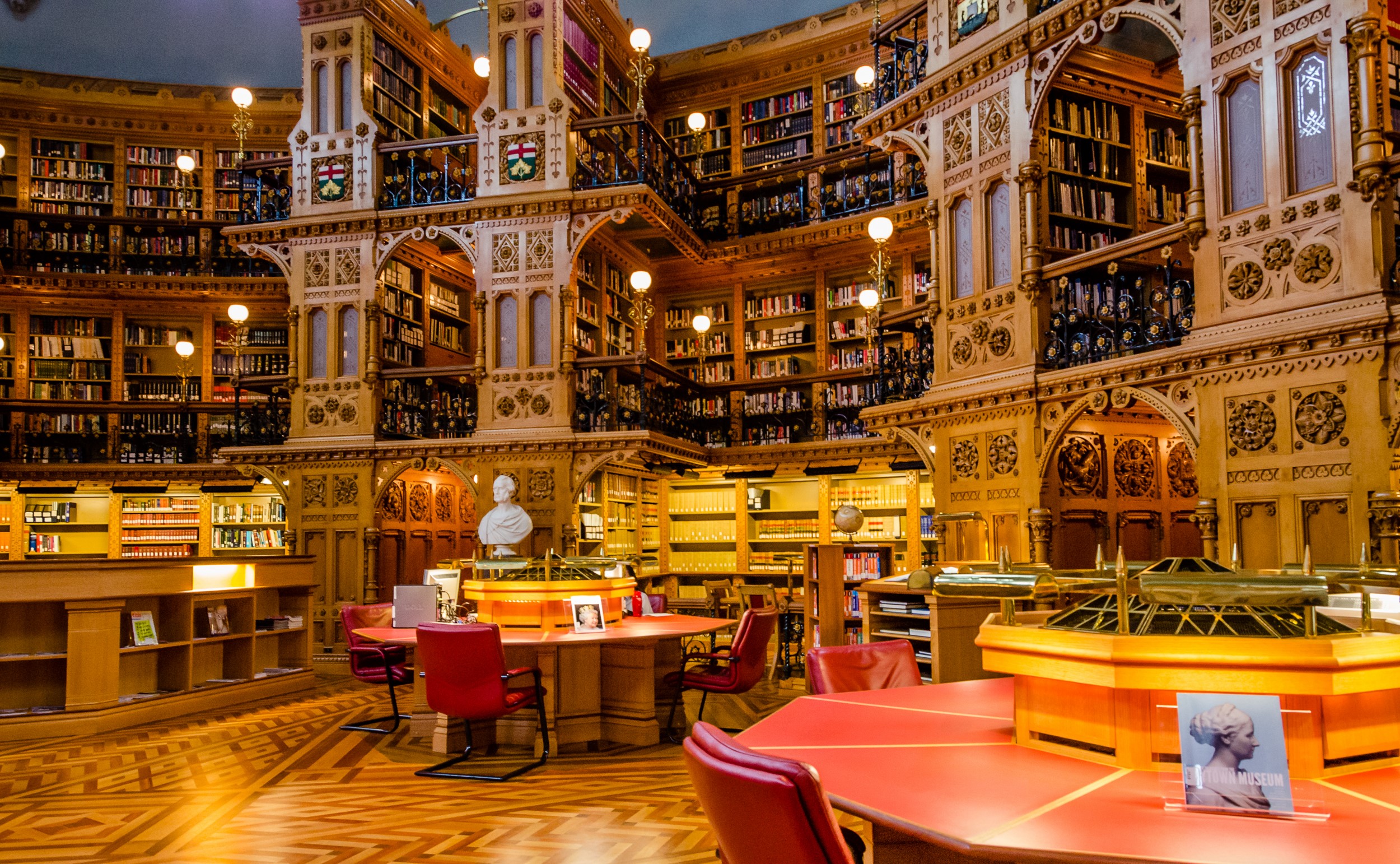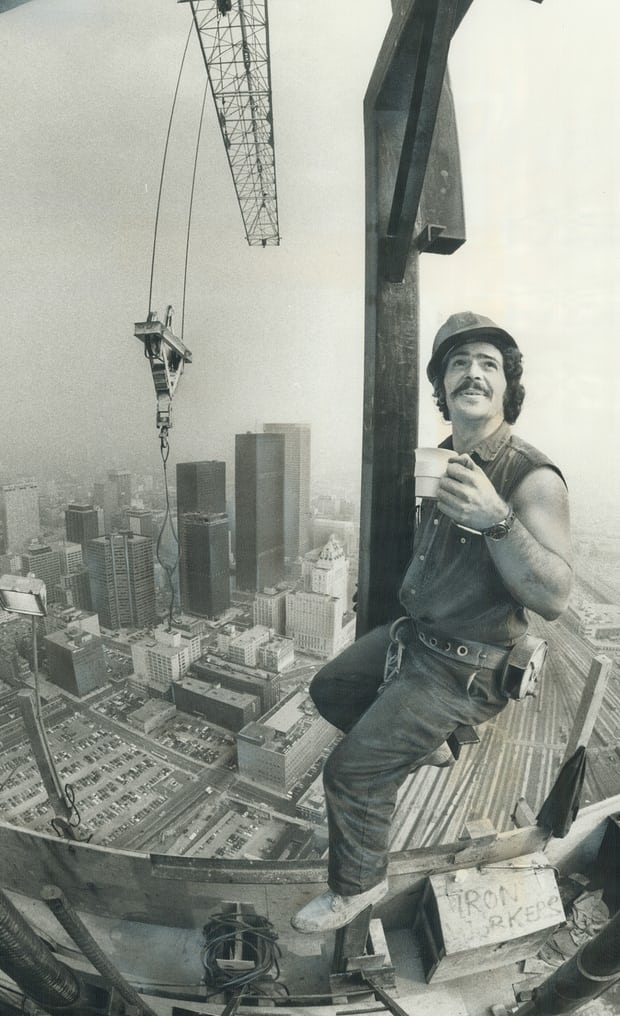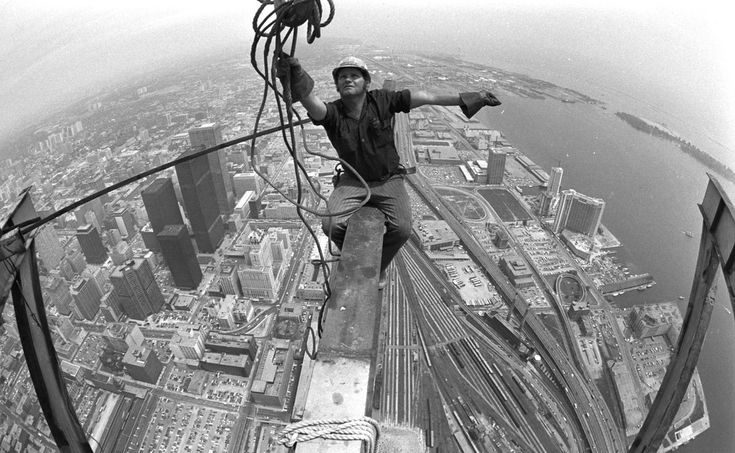 On the National News, a tour through the completed renovations of the Library of Parliament, in Ottawa. This is no ordinary library. Completed only nine years after Confederation (the formation of Canada as a nation-state), it is a magnificent High Victorian Gothic fantasy, a circular cone of flying buttresses and multi-coloured stone that rises atop the cliffs along the Ottawa river. The interior is very beautiful, employing a circular, radiant plan. Light streams into it from the sky, in the manner of a cathedral. In the nineteenth century, Canada still retained its tradition of fine craftsmanship in wood, and the work that was done in this library is the equal of anything in the world. On the news item, one Member of Parliament, who was a journeyman carpenter in his youth, said “this stuff is porn for any carpenter”.
On the National News, a tour through the completed renovations of the Library of Parliament, in Ottawa. This is no ordinary library. Completed only nine years after Confederation (the formation of Canada as a nation-state), it is a magnificent High Victorian Gothic fantasy, a circular cone of flying buttresses and multi-coloured stone that rises atop the cliffs along the Ottawa river. The interior is very beautiful, employing a circular, radiant plan. Light streams into it from the sky, in the manner of a cathedral. In the nineteenth century, Canada still retained its tradition of fine craftsmanship in wood, and the work that was done in this library is the equal of anything in the world. On the news item, one Member of Parliament, who was a journeyman carpenter in his youth, said “this stuff is porn for any carpenter”.
When the original Parliament Buildings burned to the ground, in 1916, the library was protected by massive steel doors, and survived unscathed. The collection, though it includes rarities like an Audubon folio worth $14,000,000, is primarily a working library. The bulk of the collection is works of history, law, or economics. Members of the government and opposition are meant to research legislation there, and, in fact, whenever I’ve been there, I’ve seen MPs at work. It is only steps away from the floor of Parliament itself, and its beauty and calm make it a natural place to flee when the rancour of the parliamentary scrum gets unnerving.
The chief contractor who won the bid to conduct the renovations is the great-grandson of the original architect. He spoke with great pride about the work, as did, in fact all the subcontractors and artisans working on the reconstruction. I like to see pride like that.
Meanwhile, here in Toronto, this weekend saw the thirtieth aniversary of the completion of the CN Tower. It commemorates the tower’s opening date to the public, rather than the earlier day that almost every Torontonian then alive remembers — the day the mast was attached by Olga, the giant Sikorsky helicopter, piloted by Larry Pravecek. On that day, the city was transfixed. The elevated freeway that runs past the tower spontaneously became a parking lot, as every traveller stopped to get out of their car and watch the spectacle. One of the tough breed of high construction workers climbed to the very tip and set off a smoke bomb.

Construction worker Yvon Rainville: “I was drinking my coffee as usual – black, with two sugars – since it was just an ordinary working day for me. But Boris Spremo, the legendary photographer for the Toronto Star, had come to the tower…– just over six months after construction started. It wouldn’t be finished for another three years. He asked if I minded having my photograph taken. I didn’t, so he did.. I was there for nine months, as a rodman – installing the metal rods that run through the building like a skeleton. Later, we got danger pay if we worked above 1,000 feet…. There was a real spirit of camaraderie on the CN Tower. We were a big extended family, all 1,537 of us: the iron men looked out for the carpenters, the carpenters looked out for the stonemasons. A construction site couldn’t operate if there wasn’t that feeling among the workers.”
The CN tower was not built as a monument, but as a private project for the CN Railways telecommunications division, and paid for itself in fifteen years. At 181 stories, or 553.3 m (1,815 ft), it still remains, surprisingly, the world’s tallest. The builders had worked on the assumption that it would only hold the title for a decade, at most. Nobody seriously suggested it would remain tallest for three decades. But the advent of reliable satellite service eventually made the need for clear-line-of-sight communications unnecessary. Towers of this type are no longer likely to be built. However, several taller structures for other purposes are currently under construction. It will not hold the title much longer.
It is not simply a pillar of concrete. It’s actually hollow. Someone could drop a rubber ball from quite near the top, and watch it bounce ten thousand times, or whatever. The revolving restaurant and observation decks are reached by high-speed elevators that take only a minute to ascend. They are on the outside of the structure, and glass-walled, so the experience is exhilarating. The glass floor of the observation deck consists of laminated thermal glass panes that are 64 mm thick, and which are supposed, according to the builders, to be able hold the weight of fourteen adult male hippopotomi (who thinks of these things as contingencies?). Some people experience vertigo by walking out on the glass floor and looking down at the ground below. It’s a must-not-see for agoraphobes and acrophobes. The staircase is not normally open to the public, since it would require a permanent rescue team to retrieve stranded climbers. But it is climbed by thousands of people every year for charity events. It has also been climbed by pogo stick, and once by someone dragging a piano. I have never been tempted to climb it, with a piano or without.
Building such a structure in mid-1970s required major innovations in both design and construction techniques, as it presented entirely new engineering problems. It is more of a machine than a structure. It contains, for example, gigantic pendulums (pendulae?) which dampen the resonance of high winds, and its electronics must be protected from the thousands of lightning strikes it has received. The pre-stressed concrete had to be built up in a continuous pour, using a slipform that changed in shape gradually, as it moved upward at the rate of six metres per day. Many of the construction techniques had never been attempted, or, in some cases, not even been conceived.
All that, of course, took place at a time when pride rode high in the city, the overcoming of obstacles was considered a sign of natural mental health, and the Conservative mentality of helplessness, greed, mean spiritual squalor, and defeat had not yet subverted our society.
 Interviews with the men who built that tower ― they were all pretty young then, and most are still around ― reveal a pride in good work, a self-respect, and a public spirit that is today altogether unfashionable. Not just the engineers and architects and other big shots. The men who poured the concrete and stretched the steel, and the man who danced on the tip on that triumphant day. Pride. And even those who worked in more mundane jobs. Faizal Haq arrived from Pakistan, as a teenager, and got a job as a cashier. He is still there, now Chief Financial Officer. Pride.
Interviews with the men who built that tower ― they were all pretty young then, and most are still around ― reveal a pride in good work, a self-respect, and a public spirit that is today altogether unfashionable. Not just the engineers and architects and other big shots. The men who poured the concrete and stretched the steel, and the man who danced on the tip on that triumphant day. Pride. And even those who worked in more mundane jobs. Faizal Haq arrived from Pakistan, as a teenager, and got a job as a cashier. He is still there, now Chief Financial Officer. Pride.
Now, look at the slimy little maggots who run things in our times. Look at all the Bush Conservatives in the U.S.A. and the tamer, pipsqueak Harper Conservatives in Canada. Look at the pinch-nosed bean-counters and neo-conservative zealots. Look at the gay-haters and the bible-thumpers and the Patriot Act Commisars. Look at all those who panic us with fear-mongering and assault the dignity of the free, individual human being. They can create nothing. They will not build any libraries or solve any technical problems. They can only bully and destroy. What is it that they hate most of all? What all bullies hate and fear: Pride.
0 Comments.